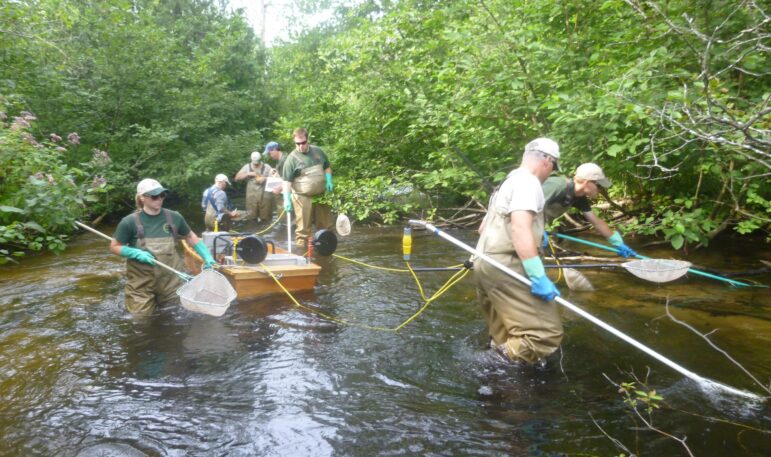
Department of Natural Resources.
DNR fisheries workers survey a streamBy MORGAN WOMACK
Capital News Service
LANSING – If you’re a fish swimming in a Michigan stream, prepare to be shocked.
Literally.
Using electrofishing equipment to temporarily stun, seize and sample fish is one technique the Department of Natural Resources (DNR) uses to conduct its annual fisheries surveys.
In 2022, more than 270 surveys took place statewide, according to the DNR. Ninety-nine were done in streams and 172 in inland lakes.
The main technique for surveying inland lakes is placing nets along the shore. This time of year, inland lake visitors can expect to see trap nets marked with buoys, said Brian Gunderman, the DNR Fisheries Division’s Southern Lake Michigan unit manager.
“The general overall purpose of these surveys is they help with direct future management,” Gunderman said. “Without this information we’d be managing blind.”
The survey results can be used internally — by helping the DNR assess its regulations and see long-term population trends — and externally — to the public, anglers, associations and conservation groups.
Gunderman said walleye and pike surveys start in early spring, followed by muskie surveys. In May, the DNR starts surveying general fish communities like panfish and bass, and from July to September it surveys streams.
The surveys also help the DNR stock populations of fish.
For example, Gunderman said the DNR plans to continue stocking Allegan County’s Selkirk and Osterhout lakes and Montcalm County’s Crystal Lake with walleye due to their successful survival rates.
To stock the rivers with fish, the DNR needs to collect eggs.
One egg-taking location is the Little Manistee River Weir in Manistee County.
Central Lake Michigan unit manager Scott Heintzelman said along with eggs, the weir collects biological information.
Right now, the weir is collecting steelhead eggs. In the fall, it will collect Chinook salmon eggs.
“It’s been a great place to kind of get some information on how these Great Lakes populations are doing based on what we collect there,” Heintzelman said.
In 2022, Heintzelman’s unit surveyed the Pentwater River system, which hadn’t been surveyed in about 30 years. The crew found still-thriving populations of brown trout, steelhead and salmon.
He said such data can help the DNR decide other priorities, like dam removals and road crossings.
“Having that fish community information adds weight to our applications for grants and things like that,” Heintzelman said. “Fisheries are important drivers with getting some of the overall habitat and water quality work done as well.”